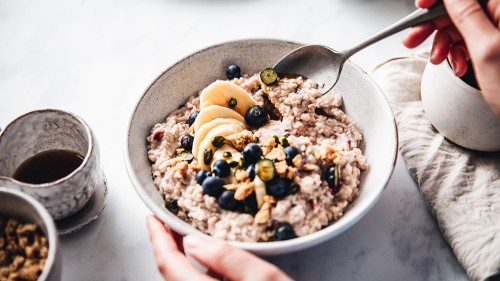8 Effective Evidence-Based Ways to Burn Body Fat
Published on March 9, 2022
Medically Reviewed by Natalie Olsen, MS, RDN
There exists no shortage of information on ways to burn body fat, but most of this advice is unreliable and often dispensed by someone who has something to sell you. Instead, try implementing one, a few, or all eight of these evidence-based ways to lose body fat.


Whether to improve physical or mental health, increase energy levels, or reduce joint pain, losing body fat is a goal shared among many people.
But in today’s world of endless diets, supplements, and fitness challenges claiming to help you burn body fat, it can be difficult to cut through the noise to know what is actually evidence-based.
This article lists eight evidence-based ways to burn body fat to implement in your life today.
1. Find a Diet That You Can Stick With
There’s nothing inherently special about popular diets. They may have different “diet rules” in which they restrict or only allow certain foods, but they all typically create a deficit.
A calorie deficit occurs when you eat fewer calories than you burn. This is one component of weight loss, although other variables such as sleep habits, stress, and hormone balance influence weight management as well.
Any diet can work and help you lose body fat, but many diets tend to be difficult to follow long-term, leaving many to quit the diet and regain lost pounds. (1)
To this point, a diet is only as effective as your ability to follow it long-term.
So, find a sustainable dietary pattern based on your preference and lifestyle that focuses on balance without too much sacrifice.
Put It Into Action
A calorie deficit of 300–500 per day works well for most people. You can create a calorie deficit by eating fewer calories, increasing physical activity, or both. Focus on sustainable changes rather than over restriction.
2. Prioritize Sleep
Sleep is grossly underappreciated for weight loss.
Just one night of poor sleep can increase next-day hunger and cravings for sweets, which can promote weight gain over time.
In one study, 80 adults who consistently slept less than 6.5 hours per night were either instructed to maintain their current sleep habits or were counseled on good sleep habits to increase their sleep by an average of 1.2 hours per night. (2)
After two weeks, the participants who increased their sleep consumed significantly fewer calories (270 calories) compared with those who stuck with their usual 6.5 hours of sleep.
The study’s authors predicted this daily 270-calorie decrease could result in a weight loss of 26 pounds (12 kg) over three years.
Put It Into Action
Aim to sleep 7–9 hours per night. Go to bed and wake up at the same time, including on the weekends. Turn off all electronics, including your phone, at least 30 minutes before bed.
3. Eat More Fiber
Fiber is a non-digestible carbohydrate and component of plant cell walls.
Due to its indigestibility, fiber promotes satiety and can help with weight loss.
Findings from multiple reviews of randomized controlled trials have shown that higher fiber intakes lead to significantly greater decreases in body weight independent of a calorie restriction. (3, 4)
Fiber also supports healthy cholesterol and blood sugar levels, bowel regularity, and has been shown to reduce the risk of several types of cancer.
The best sources of fiber include fruits, vegetables, whole grains, legumes, nuts, and seeds.
Fiber supplements, both in powder and pill form, are also an option, but then you miss out on the other beneficial nutrients that fiber-rich foods provide.
Put It Into Action
Aim to consume at least 14 grams of fiber for every 1,000 calories you eat, or 25 grams for women and 38 grams for men daily. Fiber above this amount can offer greater benefits. Increase your fiber intake slowly over the span of several days to avoid stomach upset or constipation.
4. Up Your Protein
Protein has three advantages for fat loss: (5)
- It increases metabolism. Compared with carbs or fats, protein requires the most energy or calories to digest and absorb.
- It increases satiety. Protein intake helps you feel full and stay full longer, which can deter overeating.
- It supports lean body mass retention. Protein helps prevent the loss of muscle mass that generally occurs with weight loss, thereby maintaining your metabolism.
You can get protein from both animal and plant sources.
Animal-based protein sources include:
- Poultry, including eggs, chicken, turkey, quail, and duck.
- Meat, including beef, pork, goat, lamb, and venison.
- Seafood, including fish and shellfish.
- Dairy, including milk, yogurt, and cottage cheese.
Plant-based protein sources include:
- Legumes, including beans, peas, and lentils.
- Nuts and seeds.
- Dairy alternatives, namely soy milk.
Put It Into Action
Choose minimally processed protein options when possible. Consume 20–30 grams of protein with each meal. Aim for 0.55–0.73 grams per pound (1.2–1.6 grams per kg) of body weight of protein each day.
5. Resistance Train
Engaging in regular, consistent exercise has a myriad of health benefits ranging from better sleep and mood to protection against several chronic diseases.
Beyond these benefits, exercise, especially resistance training or weightlifting, supports fat loss.
Your muscles are the largest site of glucose or blood sugar uptake, so training them and keeping them strong helps prevent body fat storage while also increasing metabolism. (6)
Resistance training is especially important when following a low-calorie diet for preserving muscle mass and metabolism.
Like establishing and maintaining the other healthy habits on this list, regular resistance training is also crucial for supporting weight loss maintenance and preventing weight regain.
Put It Into Action
Incorporate resistance training that works all major muscle groups — chest, back, arms, core, legs, and shoulders — at least two days per week. Gradually increase the weight, frequency, or number of repetitions you do over time. Incorporate bodyweight exercises, free weight exercises (like dumbbells and barbells), or machine exercises.
6. Track Your Behaviors
Self-monitoring involves tracking your behaviors in connection with efforts to change or control that behavior, which tends to be negative or damaging.
Self-monitoring can be useful for many things, like improving work or academic performance. Still, it’s also very useful for promoting lifestyle changes that lead to weight loss or prevent weight gain or regain.
Food diaries, weekly weigh-ins, or taking waist and hip measurements are some useful self-monitoring techniques.
By practicing these self-monitoring techniques, you can identify actions or behaviors that are pushing you further from your health goals so you can correct them.
Keeping a food diary involves tracking what you eat and drink but also how you feel in the moment. Do you feel hungry, stressed, bored, or tired?
Certainly, the energy or calorie content of the things you eat and drink matters for fat loss, but so do the feelings associated with your choices.
For example, you may notice that you drink more soda the day after a poor night’s sleep or that you turn to ice cream when you’re stressed.
By keeping a food diary, you can become aware of these links and work to break them.
Self-weighing or taking body measurements can also be helpful for regulating your food and calorie intake based on watching your trends.
More frequent self-weighing is associated with greater weight loss and weight-loss maintenance compared with less frequent self-weighing. (7)
Contrary to some reports, a study involving 250 adults reported no evidence of disordered eating or distorted body image when using self-monitoring techniques like self-weighing and keeping a food diary. (8)
However, self-monitoring techniques may worsen and therefore be inappropriate for people with a history of these disorders.
Put It Into Action
If you’re not a standard journal-type person, there are several mobile apps you can use to track eating habits.
Weigh yourself using the same scale at roughly the same time of the week, wearing the same clothing or nothing at all.
Since weight fluctuates day-to-day, it is best to weigh in only once or twice a week at the same time. For example, every Sunday morning. Some may desire to weigh more frequently. Find what works best for you.
Some people may prefer taking measurements instead of weighing in. Use a tape measure to measure around your hips at the widest part and your waist at the smallest part, typically by the belly button. Aim for measuring every 2–4 weeks.
7. Limit Ultra-Processed Foods
The rise in global obesity prevalence over the past several decades has been driven largely by changes in the food environment.
Economic and policy influences have maximized the production of cheap products like corn and soy to an increasingly industrialized food system that produces inexpensive, convenient, high-processed foods.
These ultra-processed foods contain high amounts of salt, sugar, fat, and flavor additives designed to drive appetite and consumption.
And while many people like to point to a lack of “self-control” as the reason why people become overweight and obese, the fact is that the brain is the primary organ that — below our conscious awareness — regulates body weight. (9)
In other words, even if you think you are in complete control of your food choices, there are complex hormonal, metabolic, and nervous system signals happening behind the scenes that control your food intake in response to ultra-processed foods.
As such, you should limit high-processed foods as much as possible.
Examples of ultra-processed foods include:
- Sugary drinks like soda and sweet tea.
- Diet drinks.
- Chocolate and candies.
- Ice cream and frozen desserts.
- Most fast food.
- Frozen entrees.
- Bakery products.
- Processed meats.
- Packaged snacks.
- Sweetened breakfast cereals.
Put It Into Action
Save your favorite treats for special events and holidays.
Not everyone has access to or can afford to eat a minimally processed diet but do what you can to eliminate some of the ultra-processed foods in your diet.
Eliminating or avoiding sugar-sweetened beverages like regular and diet soda, energy drinks, sweet tea, or specialty coffee drinks is one of the best things you can do for weight loss and your health.
8. Meal Plan and Prep
Meal planning and preparation are crucial for fat loss, especially if you have a busy schedule.
Having your meals planned and prepared eliminates decision fatigue, the idea that after making many decisions during the day, your ability to make additional decisions becomes worse.
Once you reach the point of decision fatigue, you’re more likely to make impulsive decisions, such as stopping by your favorite burger joint on the way home from work because it’s easier than spending 30–60 minutes preparing and cooking a healthy meal at home.
Therefore, it’s always smart to have healthy meals and snacks prepared so you don’t make impulsive decisions that could hinder your weight loss efforts.
You don’t have to prep all your meals, but generally, the more prep work you do, the better results you’ll have.
Indeed, meal planning has been associated with a healthier diet and reduced body weight. (10)
Put It Into Action
Designate a day for meal planning and shopping. Batch-cook proteins and carbs if you don’t have much time to spend cooking during the week. Use meal-prep tools like food storage containers to pre-portion your meals.
Frequently Asked Questions
How do you burn body fat?
Creating a calorie deficit is one way to help burn fat.
You can create a calorie deficit by eating fewer calories, increasing your energy output by exercising, or both. For most people, it's much more sustainable to create a calorie deficit by eating less.
What's the fastest way to lose body fat?
Focusing on sustainable ways of weight loss increases the likeliness of keeping the weight off.
You can lose weight by being mindful of your calorie intake and creating a deficit. However, creating too large of a deficit can result in more weight loss from muscle rather than body fat.
It can also increase hunger and cause other side effects such as low energy, cold intolerance, irritability, and poor sleep quality.
A calorie deficit of 300–500 calories is appropriate and safe for most people.
What's the best way to lose body fat?
One of the most sustainable ways to lose body fat for most people is by decreasing calories by 300–500 per day.
The lifestyle changes you make to accomplish this deficit will look different for everyone. Just make sure that the changes you do make you can sustain long-term.
Resistance training also helps improve lean body mass, increases metabolism, and this helps burn fat.
Can you spot reduce fat?
Some data suggests that spot reduction is possible with resistance training, but you generally cannot determine from where you lose body fat.
When is your body in fat burning mode?
The “fat-burning” mode generally refers to the range of heart-rate intensity in which more calories are burned from fat compared with carbs or protein.
However, it’s the total calories you expend that matter for fat burning, not necessarily what energy source contributes to those calories.
The Bottom Line
At the core, losing body fat requires that you consistently consume fewer calories than you burn.
You can do this by finding a healthy dietary pattern that works for you and your lifestyle.
Along with making changes to your diet, prioritizing sleep, increasing your fiber and protein intake, and engaging in regular resistance training are also crucial for weight loss and weight loss maintenance.
Other evidence-based ways to lose body fat include tracking your behaviors as they relate to food, limiting your intake of ultra-processed foods, and meal prepping and planning.
At WellnessVerge, we only use reputable sources, including peer-reviewed medical journals and well-respected academic institutions.
- Strategies to Improve Adherence to Dietary Weight Loss Interventions in Research and Real-World Settings:
https://www.ncbi.nlm.nih.gov/pmc/articles/PMC5618052/ - Effect of Sleep Extension on Objectively Assessed Energy Intake Among Adults With Overweight in Real-life Settings: A Randomized Clinical Trial - PubMed:
https://pubmed.ncbi.nlm.nih.gov/35129580/ - Can dietary viscous fiber affect body weight independently of an energy-restrictive diet? A systematic review and meta-analysis of randomized controlled trials - PubMed:
https://pubmed.ncbi.nlm.nih.gov/31897475/ - Effect of viscous fiber supplementation on obesity indicators in individuals consuming calorie-restricted diets: a systematic review and meta-analysis of randomized controlled trials - PubMed:
https://pubmed.ncbi.nlm.nih.gov/32198674/ - The role of protein in weight loss and maintenance - PubMed:
https://pubmed.ncbi.nlm.nih.gov/25926512/ - Skeletal Muscle Insulin Resistance Is the Primary Defect in Type 2 Diabetes:
https://www.ncbi.nlm.nih.gov/pmc/articles/PMC2811436/ - Frequency of Self-Weighing and Weight Change: Cohort Study With 10,000 Smart Scale Users - PubMed:
https://pubmed.ncbi.nlm.nih.gov/34075879/ - Self-monitoring has no adverse effect on disordered eating in adults seeking treatment for obesity - PubMed:
https://pubmed.ncbi.nlm.nih.gov/29951219/ - The energy balance model of obesity: beyond calories in, calories out:
https://academic.oup.com/ajcn/advance-article/doi/10.1093/ajcn/nqac031/6522166?login=false - Meal planning is associated with food variety, diet quality and body weight status in a large sample of French adults:
https://www.ncbi.nlm.nih.gov/pmc/articles/PMC5288891/






